Introduction
Have you ever wondered what it would be like to see your favourite book come to life, not on a movie screen, but in your own imagination, aided by the power of AI? Welcome to the future of reading, where AI tools like Midjourney are enabling our ability to visualise text – be it your favourite book, song or poem.
Why I chose Norwegian wood
There’s a certain magic in the pages of a good book, a kind of alchemy that can transport you to different worlds, introduce you to new perspectives, and even change the way you see your own life. One such book for me is Haruki Murakami’s “Norwegian Wood.”
I first read “Norwegian Wood” when I was 20, the same age as Toru, the book’s protagonist. At that age, I was grappling with many of the same questions and emotions that Toru was – questions about love, loss, and the bittersweet transition from adolescence to adulthood. The book resonated with me on a deeply personal level, and it has stayed with me ever since. Reading it again is interesting, as Toru, aged 37, is also the Narrator looking back at his life – a similar age to me now:
I was 37 then, strapped in my seat as the huge 747 plunged through dense cloud cover on approach to Hamburg airport… I straightened up and looked out of the wind at the dark clouds hanging over the North Sea, thinking of all I had lost in the course of my life: times gone for ever, friends who has died or disappeared, feelings I would never know again… I could smell the grass, feel the wind on my face, and hear the cries of the birds. Autumn 1969, and soon i would be 20.
Haruki Murakami
What struck me most about “Norwegian Wood” was the style and beauty of Murakami’s prose (and credit to Jay Rubin for the translation from Japanese). His writing is evocative and poignant, painting vivid pictures of the characters and their surroundings. I’ve since read every book of his, but Norwegian Wood is still my favourite.
Now, with the help of AI tools like Midjourney, I am able to visualise “Norwegian Wood” in a whole new way. I’ll show you how I did this below.
Using Midjourney to create cinematic scenes
I used MidJourney to generate the images. It’s a discord based application, which means you may have a little learning curve to set it up. A detailed set-up and a user guide are here : https://docs.midjourney.com/

Rendering the characters
The characters in Norwegian wood are drawn with depth and complexity. … the story revolves around three main characters, each one unique and complex in their own way. Their interactions, their relationships, their personal journeys – these are the heart of the book.
Toru Watanabe, the protagonist and the character I identified with. Toru is a student, introspective and somewhat reserved. He’s a keen observer of the world around him, and his thoughtful nature is reflected in his interactions with the other characters. At the age of 20, he’s grappling with the complexities of love and loss.
Naoko, a beautiful and enigmatic young woman who shares a deep connection with Toru. They are bound by a shared tragedy – the death of their mutual friend, Kizuki. Naoko is a character marked by sadness and fragility, but there’s a strength in her too, a resilience that shines through in her moments of vulnerability. The moment of Naoko’s suicide is a turning point in “Norwegian Wood,” a moment that sends ripples through the narrative and leaves a profound impact on Toru.
Midori, a character who is, in many ways, the opposite of Naoko. Midori is vibrant, outgoing, and full of life. She’s a free spirit, unafraid to speak her mind and live life on her own terms. Her relationship with Toru adds a new dimension to the story, introducing elements of hope and renewal.
Each of these characters brings something unique to the story.
What you’ll find as you seek to visualise characters using Midjourney (or any GenAI visualisation app), is getting character consistency is really hard. Through much trial and error, i’ve found the best way is to use the names of real life actors in your prompts.
Descriptions of the the characters and the actors I used to represent them are set out below.
Toru Watanabe
Description: Toru is of average height and build, with a casual, slightly unkempt appearance. His black hair is usually slightly messy, giving him a boyish charm. His eyes, a warm brown, are thoughtful and introspective, reflecting his deep-thinking nature. He has a slightly crooked smile that lends him a friendly and approachable air.
Actor chosen: Kento Tamazaki
Test prompt & result:
[Styling: Film Still][Camera Angle: Close-up][Shot Type: Portrait][Film Type: Kodak Portra 400][Subject: Kento Tamazaki aged 20][Location: Indoor][Ambiance: Casual][Lighting: Natural][Fine tuning: His black hair is short and slightly messy. He is smiling with a crooked smile] --ar 2:1
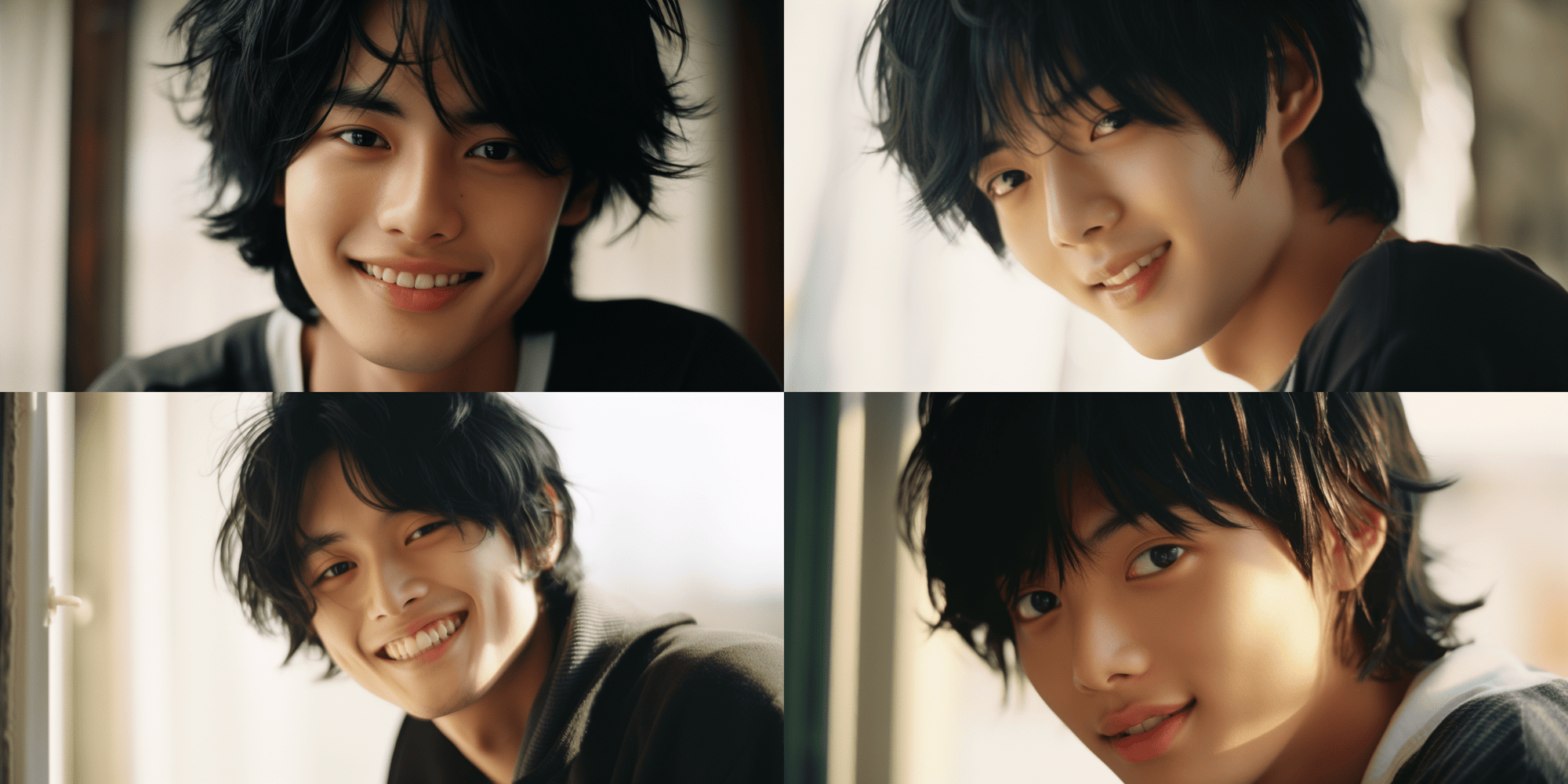
Naoko
Description: Naoko is delicate and ethereal, with long, straight black hair that frames her face. Her eyes are a deep, dark shade of brown, often filled with a sadness that hints at her inner turmoil. Her skin is pale and flawless, adding to her fragile beauty.
Actress chosen: Song Hye-kyo
Test prompt & result:
[Styling: Film Still][Camera Angle: Close-up][Shot Type: Portrait][Film Type: Kodak Portra 400][Subject: Song Hye-kyo][Location: Indoor][Ambiance: Quiet][Lighting: Natural][Fine tuning: Her eyes are a deep, dark shade of brown, often filled with a sadness that hints at her inner turmoil. Her skin is pale and flawless, adding to her fragile beauty] --ar 2:1
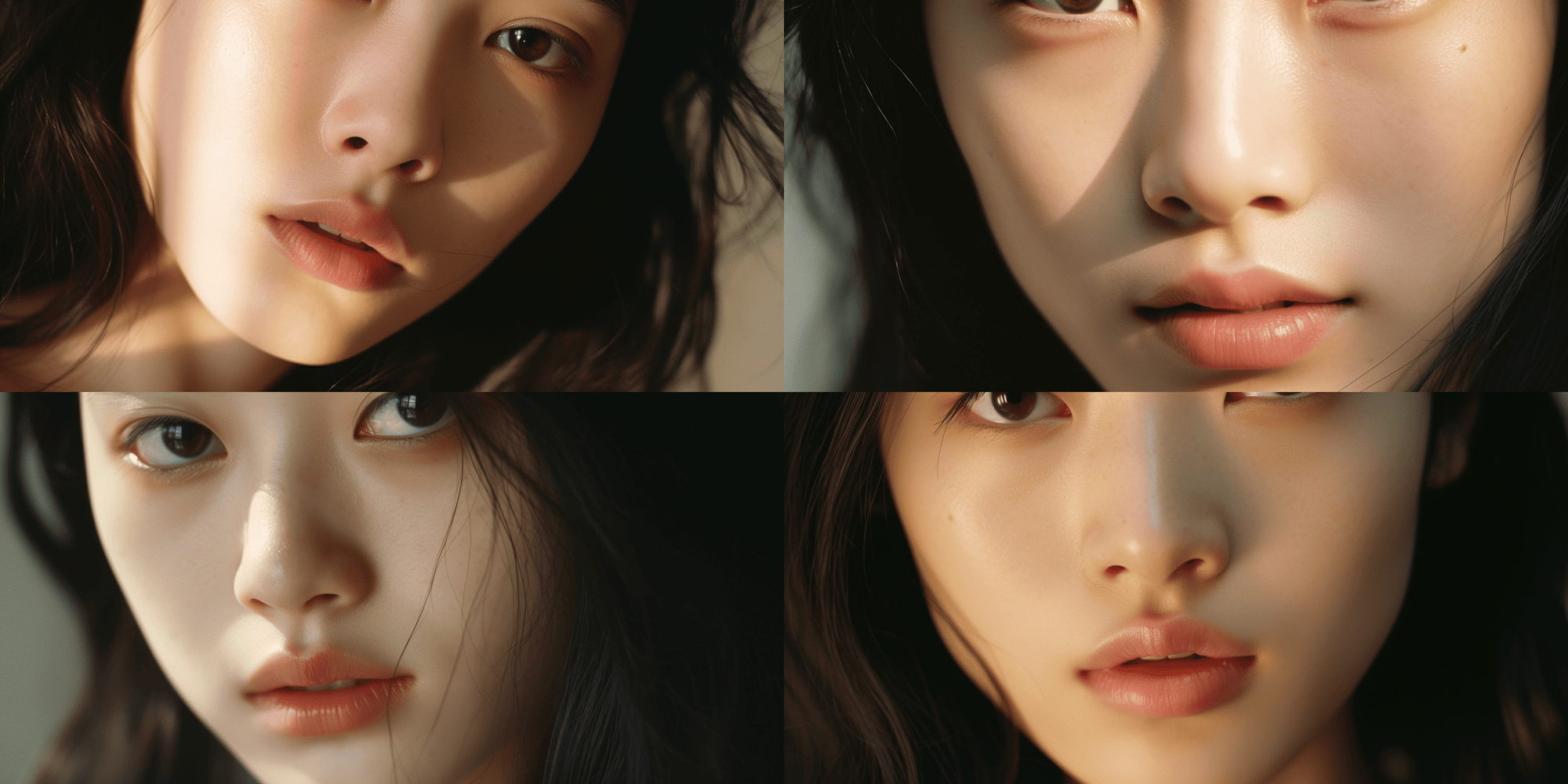
Midori
Description: She is a young woman with a distinctive appearance that matches her lively spirit. Midori has short, pixie-cut hair that she sometimes dyes in unconventional colors, reflecting her rebellious and free-spirited nature. Her eyes are bright and expressive, often sparkling with mischief or kindness. She dresses in a unique style that sets her apart from her peers, favoring bold colors and patterns that reflect her vivacious personality.
Actress chosen: Rinko Kikuchi
Test prompt & result:
[Styling: Film Still][Camera Angle: Close-up][Shot Type: Portrait][Film Type: Kodak Portra 400][Subject: Rinko Kikuchi aged 20][Location: Indoor][Ambiance: Lively][Lighting: Natural][Fine tuning: Her eyes are bright and expressive, sparkling with mischief. She is smiling] --ar 2:1

Identifying and sketching the scenes
Storyboarding is a crucial step in the process in film making – and the same technique can be used when visualising your favourite books. Here’s a simplified version of the process:
1. Script Breakdown: Go through your book and identify the key scenes that need to be storyboarded. Look for moments that require specific shots, and convey emotion.
2. Sketching: Start sketching out your scenes. The goal is to convey the composition of the shots, the movement of your characters, and the flow of action. You can use GPT-4 to do this, here is an example of a prompt to get GPT-4 to write you a 3 shot series:
[Prompt: Write a series of 3 shot cinematic visual stories based on scene {XYZ} in the book {Book name}. Break down the scene into three shots - for example, (1) A wide shot of the university campus, students moving about, engrossed in their own worlds, (2) Medium shot of Toru sitting alone, reading a book that's different from the ones his peers are reading, (3) A close-up of Toru's face, showing his thoughtful expression as he reads.Write prompt adding details:
I’ve found entering prompts into MidJourney with these components works for me:
[Styling][Camera Angle][Shot Type][Film Type][Subject][Location][Ambiance][Lighting][Fine tuning]. Example prompt following this structure:
[Styling: Rustic][Camera Angle: Eye-level][Shot Type: Wide][Film Type: Kodak Portra 400][Subject: Norwegian Wood Cabin][Location: Forest, 1960s][Ambiance: Serene and Isolated][Lighting: Natural, Soft Afternoon Light][Fine tuning: A wide shot of a traditional Norwegian-style wood cabin nestled in a serene forest. The cabin, made of rich, dark wood, stands out against the lush greenery. The soft afternoon light casts long shadows, adding depth and texture to the scene. The cabin's simple and rustic design reflects the natural beauty of its surroundings.]3. Input into MidJourney, Review and Revise:
You will see below that i revised some of the scenes as the output was not to taste (compare the original scene to final prompt).
For me one of the key parameters to adjust for accuracy in Midjourney, is the ‘Stylise’ attribute – code –S. Stylise runs from 0 to 1,000. You need to change Stylise to a low parameter (e.g. “–S 50”) in order for MidJourney to more closely follow your prompt description.
Scene by scene
Here are 7 scenes from the book, brought to life using 3 shot compositions. I have set out the quote from the book, which inspired me, the vision for each shot and the prompt i used.
Scene 1
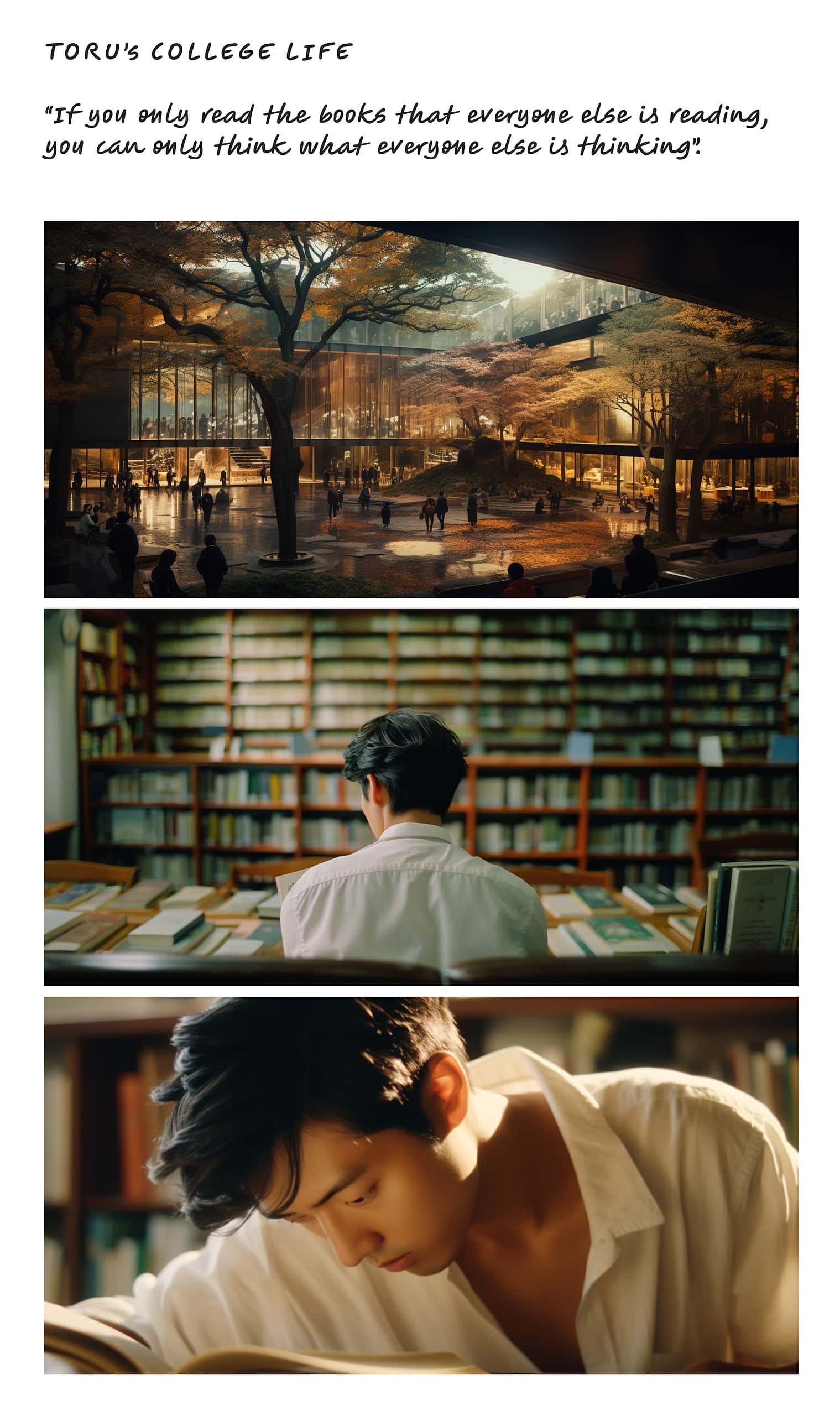
Toru’s college Life
Quote Inspiration: “If you only read the books that everyone else is reading, you can only think what everyone else is thinking.”
Shot 1: A wide shot of the university campus, students moving about, engrossed in their own worlds.
Prompt: [Styling: Film Still][Camera Angle: Bird's-eye-view][Shot Type: Wide][Film Type: Kodak Portra 400][Subject: Tokyo University Campus][Location: Tokyo, 1960s][Ambiance: Busy][Lighting: Soft][Fine tuning: Students moving about, engrossed in their own worlds] --ar 2:1Shot 2: A medium shot of Toru sitting alone, reading a book that’s different from the ones his peers are reading.
Prompt: [Styling: Film Still][Camera Angle: Shot-from-behind][Shot Type: Medium][Film Type: Kodak Portra 400][Subject: Kento Tamazaki Reading][Location: University Library, Japan][Ambiance: Quiet][Lighting: Natural][Fine tuning: Kento Tamazaki's back and the back of his head as he is reading a book, he is wearing a white shirt and has messy hair] --ar 2:1Shot 3: A close-up of Toru’s face, showing his thoughtful expression as he reads.
Prompt: [Styling: Film Still][Camera Angle: Close-up][Shot Type: Close-up][Film Type: Kodak Portra 400][Subject: Kento Tamazaki Reading][Location: Indoor][Ambiance: Quiet][Lighting: Sunset][Fine tuning: Kento Tamazaki's head as he is reading a book. He is wearing a white shirt. His hair is messy] --ar 2:1Scene 2
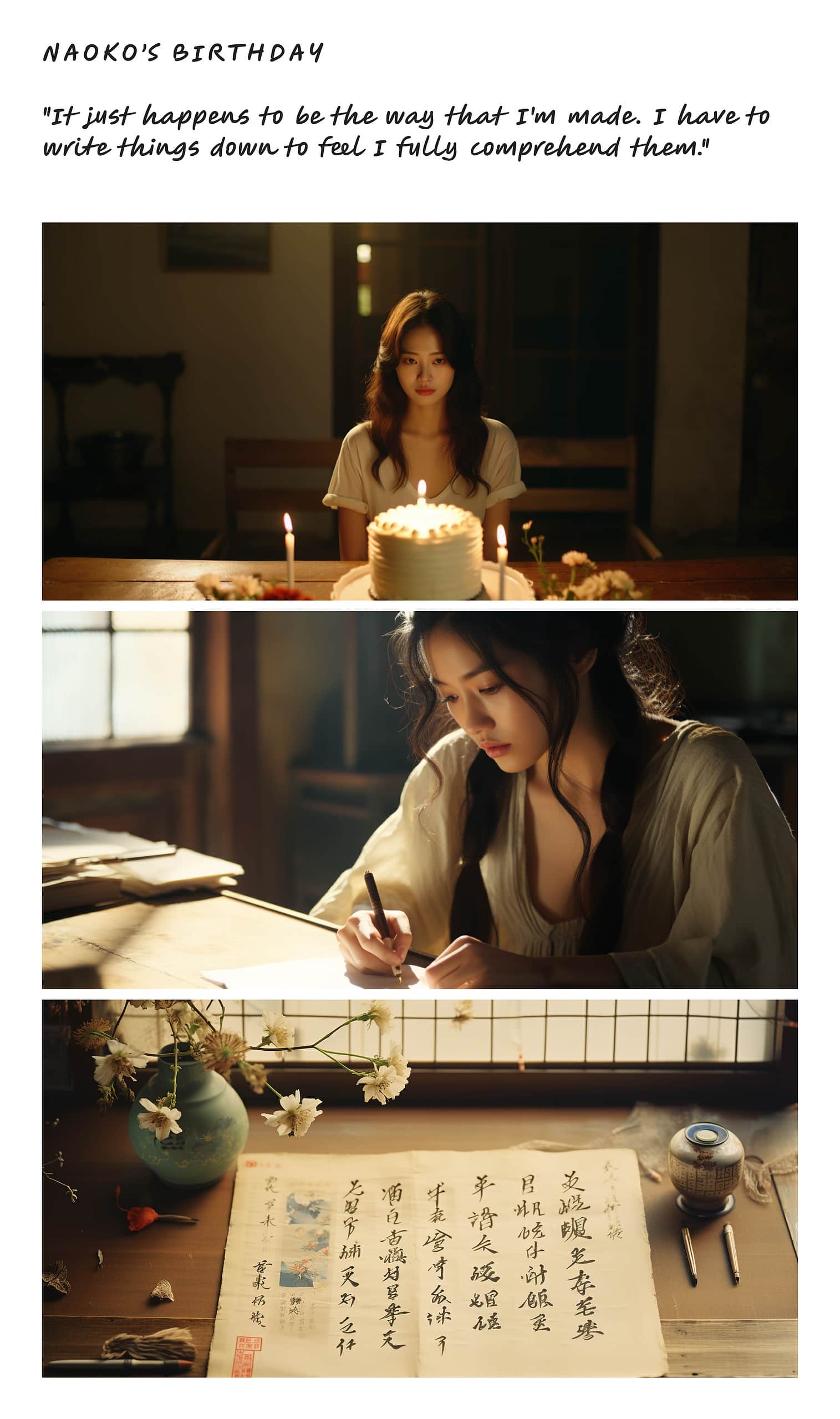
Naoko’s Birthday
Quote Inspiration: “It just happens to be the way that I’m made. I have to write things down to feel I fully comprehend them.”
Shot 1: A medium shot of Naoko, sitting alone in her room, a birthday cake in front of her.
[Styling: Film Still][Camera Angle: Medium Profile][Shot Type: Medium][Film Type: Kodak Portra 400][Subject: Song Hye-kyo aged 20][Location: Indoor, Japan, 1960s][Ambiance: Solitary][Lighting: Candlelight][Fine tuning: Song Hye-kyo is looking sadly at her birthday cake. She has long hair. She is in a dark room. She wears a simple white blouse from 1960s Japan and has long dark hair] --ar 2:1Shot 2: A close-up of Naoko writing a letter to Toru, her expression serious and focused.
[Styling: Film Still][Camera Angle: Extreme Close-up][Shot Type: Close-up][Film Type: Kodak Portra 400][Subject: Song Hye-kyo aged 20 Writing][Location: Indoor, Japan, 1960s][Ambiance: Quiet][Lighting: Natural][Fine tuning: A close-up of Song Hye-kyo aged 20 writing a letter, her expression serious and focused] --ar 2:1Shot 3: A shot of the letter, filled with Naoko’s neat handwriting, the words revealing her thoughts and feelings.
[Styling: Film Still][Camera Angle: Top-down][Shot Type: Close-up][Film Type: Kodak Portra 400][Subject: Japanese Letter on Desk][Location: Indoor][Ambiance: Quiet][Lighting: Natural][Fine tuning: A close-up of a Japanese letter on a desk] --ar 2:1Scene 3
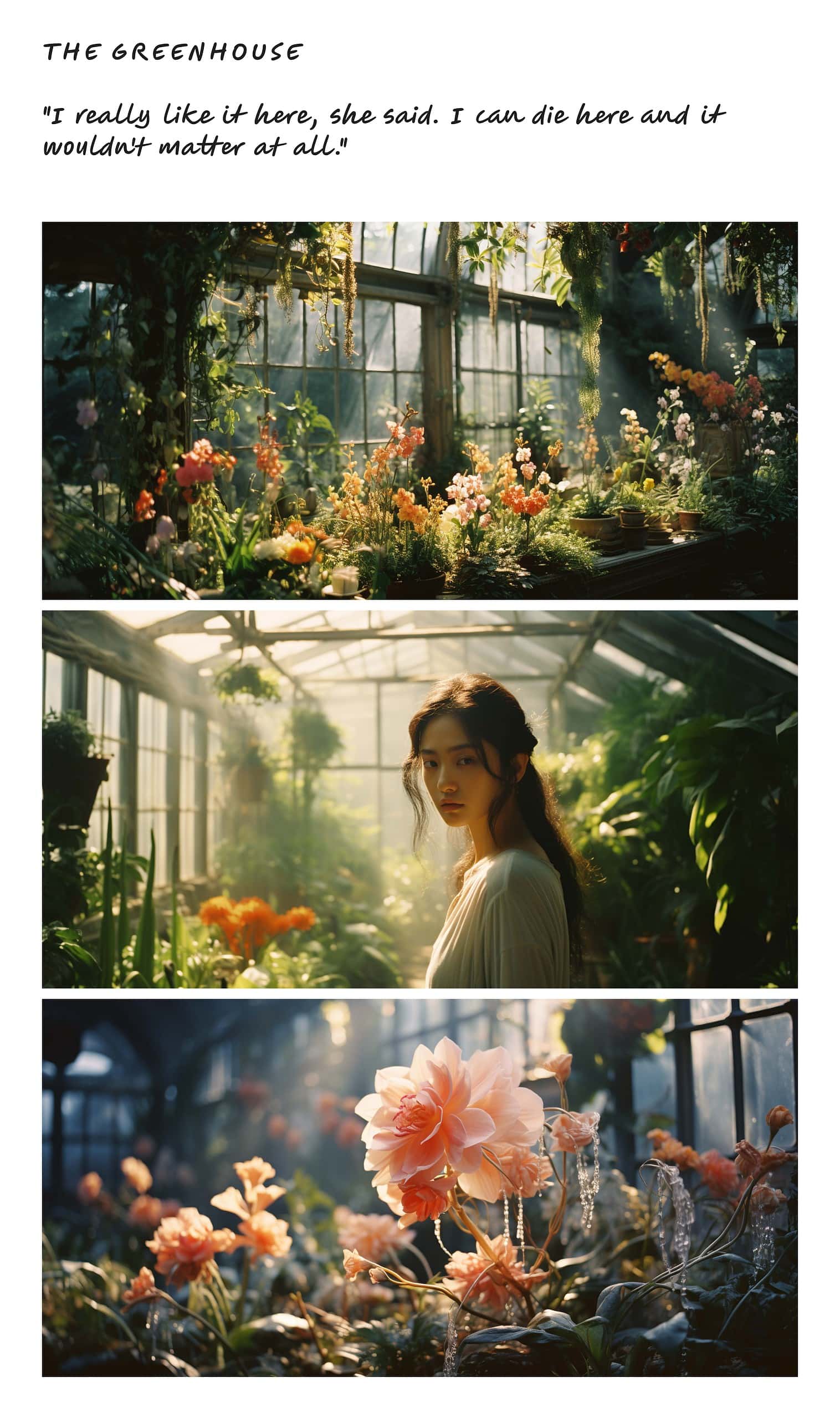
The Greenhouse
Quote inspiration: “I really like it here, she said. I can die here and it wouldn’t matter at all.”
Shot 1: A wide shot of the greenhouse, filled with lush, green plants.
[Styling: Film Still][Camera Angle: Eye-level][Shot Type: Wide][Film Type: Kodak Portra 400][Subject: Greenhouse][Location: Japan, 1960s][Ambiance: Peaceful][Lighting: Natural][Fine tuning: A wide shot of the greenhouse, filled with lush, green plants and flowers] --ar 2:1Shot 2: A medium shot of Naoko, standing amidst the plants, her expression peaceful.
[Styling: Film Still][Camera Angle: Eye-level][Shot Type: Medium][Film Type: Kodak Portra 400][Subject: Song Hye-kyo aged 20][Location: Greenhouse, Japan, 1960s][Ambiance: Peaceful][Lighting: Natural][Fine tuning: Song Hye-kyo aged 20, standing in a glasshouse amidst the plants, her expression peaceful] --ar 2:1Shot 3: A close-up of a single, beautiful flower, symbolizing Naoko’s fragile beauty and the fleeting nature of life.
[Styling: Film Still][Camera Angle: Close-up][Shot Type: Extreme Close-up][Film Type: Kodak Portra 400][Subject: Single Flower][Location: Greenhouse, Japan, 1960s][Ambiance: Peaceful][Lighting: Natural][Fine tuning: An extreme close-up of a single, beautiful flower, symbolizing Song Hye-kyo's fragile beauty and the fleeting nature of life] --ar 2:1Scene 4
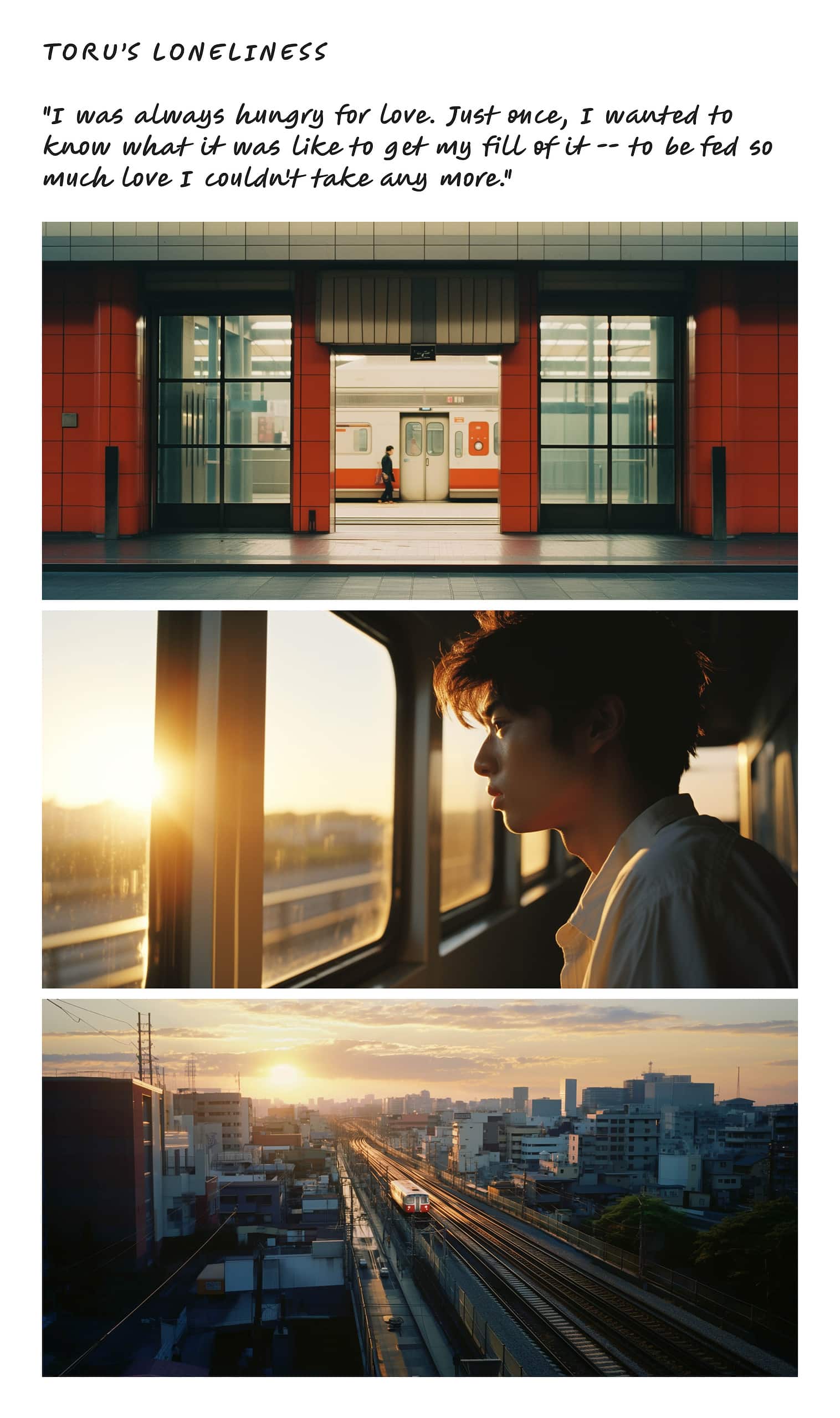
Toru’s Loneliness
Quote Inspiration: “I was always hungry for love. Just once, I wanted to know what it was like to get my fill of it – to be fed so much love I couldn’t take any more.”
Shot 1: A wide shot of the bustling Shinjuku train station, people moving about, the noise of the city serving as a constant backdrop. The station is filled with people, but Toru stands alone, a solitary figure amidst the crowd.A long shot of Toru walking alone in the city, the crowd moving around him, making his loneliness more pronounced.
[Styling: Film Still][Camera Angle: Eye-level][Shot Type: Wide][Film Type: Kodak Portra 400][Subject: Shinjuku Train Station][Location: Tokyo, 1960s][Ambiance: Busy][Lighting: Natural][Fine tuning: Train entrance doors, empty train] --ar 2:1Shot 2: A medium shot of Toru sitting alone in the Shinjuku train, his face lit up by the city lights, his expression one of longing and sadness. He is looking out the window, his reflection mirrored in the glass. The train is moving, but Toru seems to be stuck in his own world, lost in his thoughts.
[Styling: Film Still][Camera Angle: Shot-from-behind][Shot Type: Full Body][Film Type: Kodak Portra 400][Subject: Kento Tamazaki][Location: Shinjuku Train, Tokyo][Ambiance: Quiet][Lighting: Sunset][Fine tuning: Kento Tamazaki is looking out the train window at the city skyline, his body is a silhouette due to the bright sunset light coming through the train window, he is alone] --ar 2:1Shot 3: A bird’s-eye view of the Shinjuku train moving along the tracks, the cityscape sprawling around it. The train, a single entity moving through the vast city, symbolizes Toru’s loneliness and his journey through life.
[Styling: Film Still][Camera Angle: Bird's-eye-view][Shot Type: Wide][Film Type: Kodak Portra 400][Subject: Shinjuku Train Car][Location: Tokyo, 1960s][Ambiance: Busy][Lighting: Sunset][Fine tuning: Looking down on a single Shinjuku train car on train tracks, you can see the city streets] --ar 2:1 2.Scene 5
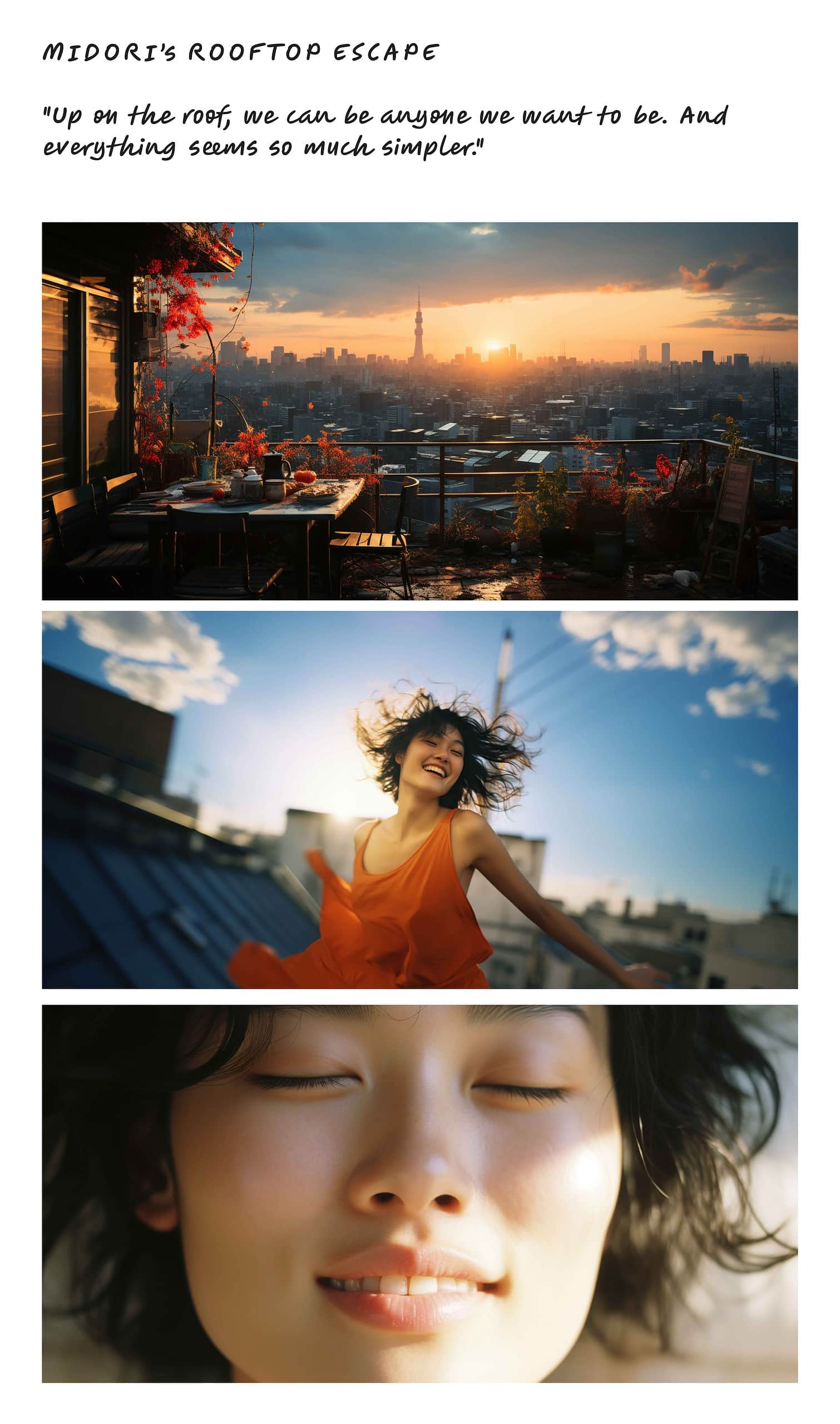
Midori’s Rooftop Escape
Quote: “Up on the roof, we can be anyone we want to be. And everything seems so much simpler.”
Shot 1: A wide shot of the cityscape, the buildings stretching out into the distance, the sky a canvas of changing colors.
[Styling: Film Still][Camera Angle: Wide][Shot Type: Panoramic][Film Type: Kodak Portra][Subject: Rooftop of Midori's Apartment Building][Location: Tokyo, 1960s][Ambiance: Peaceful][Lighting: Sunset][Fine tuning: A panoramic view from the rooftop of Midori's apartment building in the heart of Tokyo during the late 1960s] --ar 2:1Shot 2: A medium shot of Midori climbing onto the rooftop, her face lit up with a sense of freedom and excitement.
[Styling: Film Still][Camera Angle: Medium][Shot Type: Full Body][Film Type: Kodak Portra 400][Subject: Rinko Kikuchi aged 21][Location: Rooftop, Tokyo][Ambiance: Excited][Lighting: Sunset][Fine tuning: Rinko Kikuchi is climbing onto the rooftop wearing an orange silk dress from the 1960s, her face lit up with a sense of freedom and excitement] --ar 2:1Shot 3: A close-up of Midori’s face, her eyes closed, her expression peaceful as she enjoys the solitude and the breeze.
[Styling: Film Still][Camera Angle: Close-up][Shot Type: Portrait][Film Type: Kodak Portra][Subject: Rinko Kikuchi][Location: Rooftop, Tokyo][Ambiance: Peaceful][Lighting: Warm Sunshine][Fine tuning: Rinko Kikuchi with eyes closed, she is smiling] --ar 2:1Scene 6
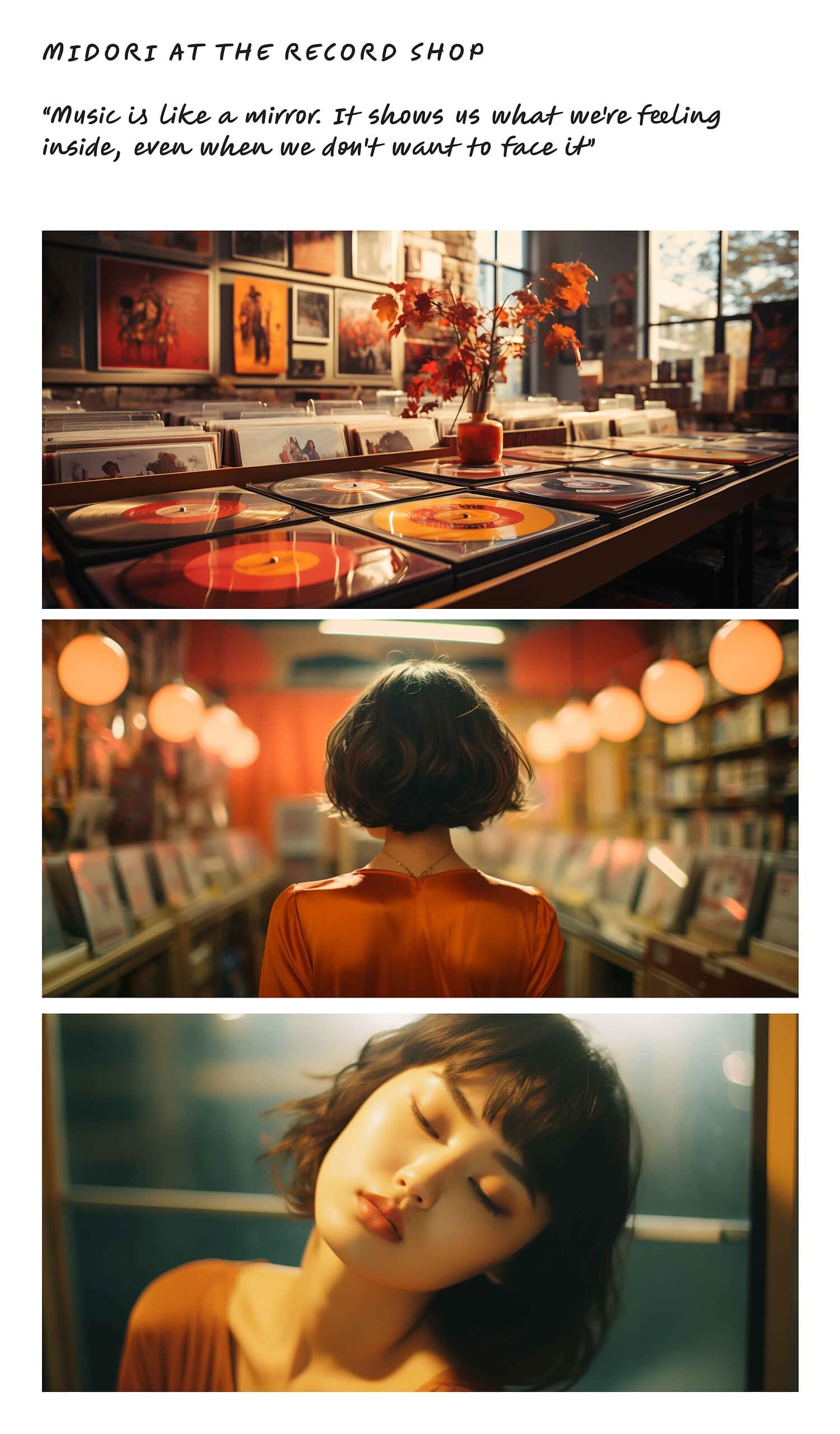
Midori at the Record Shop
Quote: “Music is like a mirror. It shows us what we’re feeling inside, even when we don’t want to face it.”
Shot 1: A wide shot of the record shop, filled with rows of records, the air filled with the soft sound of music playing.
[Styling: Vintage][Camera Angle: Eye-level][Shot Type: Wide][Film Type: Kodak Gold][Subject: Record Store Interior][Location: Tokyo, 1960s][Ambiance: Cozy][Lighting: Soft][Fine tuning: Focus on the rows of records, the details of the album covers, and the light creating a warm, nostalgic feel] --ar 2:1Shot 2: A medium shot of Midori browsing through the records, her fingers gently flipping through the albums.
[Styling: Vintage][Camera Angle: Shot-from-behind][Shot Type: Medium][Film Type: Kodak Gold][Subject: Young Japanese Woman][Location: Record Store, Tokyo, 1960s][Ambiance: Engaged][Lighting: Soft Indoor Light][Fine tuning: Focus on her's hands as they flip through the albums, her expression one of interest and anticipation] --ar 2:1Shot 3: A close-up of Midori’s face, her eyes closed as she listens to a record, her expression reflecting the emotions the music stirs within her.
[Styling: Vintage][Camera Angle: Close-up][Shot Type: Close-up][Film Type: Kodak Gold][Subject: Rinko Kikuchi][Location: Record Store, Tokyo, 1960s][Ambiance: Emotional][Lighting: Soft Indoor Light][Fine tuning: Focus on Midori's closed eyes and the subtle changes in her expression as she listens to the music] --ar 2:1Scene 7
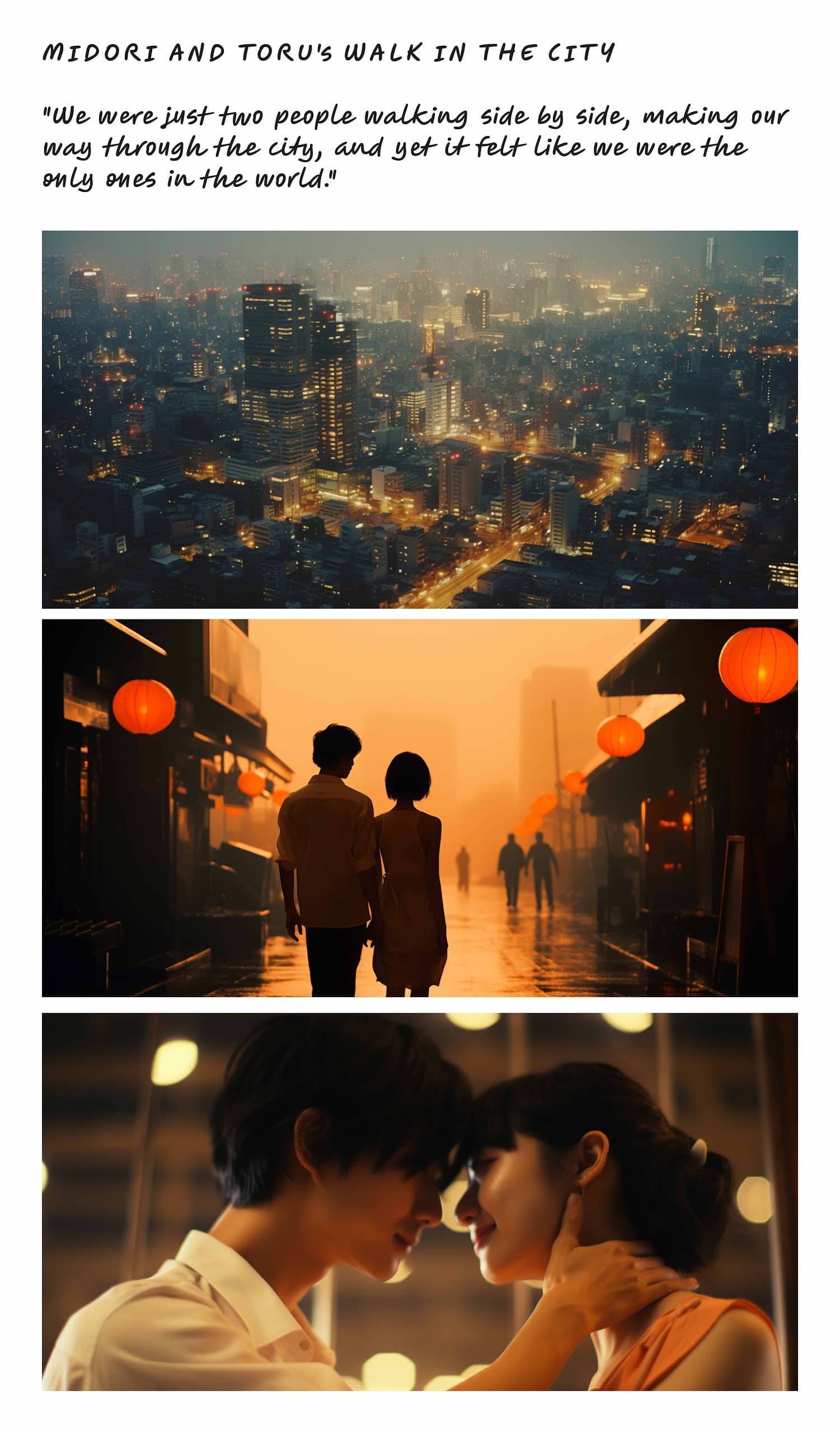
Midori and Toru’s Walk in the City
Quote: “We were just two people walking side by side, making our way through the city, and yet it felt like we were the only ones in the world.”
Shot 1: A wide shot of the bustling city, people moving about, the noise of the city serving as a constant backdrop.
[Styling: Film Still][Camera Angle: High-angle][Shot Type: Wide][Film Type: Kodak Portra 400][Subject: Cityscape of Old Tokyo][Location: Tokyo, 1960s][Ambiance: Night][Lighting: Illuminated by Lanterns][Fine tuning: The buildings illuminated by lanterns] --ar 2:1Shot 2: A medium shot of Midori and Toru walking side by side, their faces lit up by the city lights, their expressions relaxed and comfortable in each other’s company.
[Styling: Vintage][Camera Angle: Shot-from-behind][Shot Type: Full Body][Film Type: Kodak Gold][Subject: Young Japanese Man and Woman][Location: Tokyo, 1960s][Ambiance: Casual][Lighting: Natural][Fine tuning: Silhouette of a young Japanese man and woman walking together] --ar 2:1Shot 3: A close-up of their hands, slowly reaching for each other, a symbol of their growing connection and shared understanding.
[Styling: Film Still][Camera Angle: Close-up][Shot Type: Close-up][Film Type: Kodak Portra 400][Subject: Rinko Kikuchi and Kento Tamazaki][Location: Tokyo, 1960s][Ambiance: Romantic][Lighting: Soft Lamp Light][Fine tuning: Rinko Kikuchi and Kento Tamazaki looking at each other in love] --ar 2:1Closing thoughts
Reflecting on this journey from text to cinema, it’s clear that we’re standing on the precipice of a new era. The fusion of literature, cinema, and AI is not just a novelty — it’s a paradigm shift. It’s a tool that can democratise the creative process, breaking down the barriers of cost and complexity that have traditionally limited the production of films.
But this is just the beginning. As these tools continue to evolve and improve, we can expect to see a surge of new content, created by people who might never have had the opportunity to share their stories before.
So, here’s a question for you: How will you use these tools to tell your story – which poems, books, etc have you wanted to bring to life? And how will this influx of new content change the landscape of cinema and the arts?
Hat Tips
Before I wrap up, I want to take a moment to tip my hat to:
- Nick St Pierre (twitter: @nickfloats), whose educational content on Midjourney on Twitter sparked my curiosity.
- Satoshimilk (twitter: @satoshimilk), who provided the inspiration for the three image sequences

